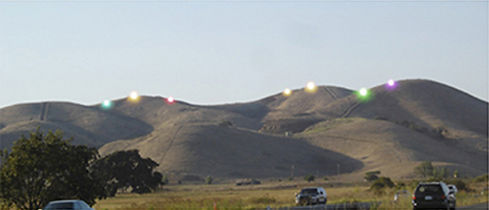


Heavenly Fragments (2008)
The Power of Light
Robbert Dijkgraaf in conversation with Liliane Lijn, chaired by Sean Cubitt
The Power of Light is a part of the event series “Light and the Dark Matters” at Tate Modern in 2015. Robbert Dijkgraaf is a mathematical physicist. His research focuses on the interface between mathematics and particle physics. Liliane Lijn is an artist and poet. She has worked across media – kinetic sculpture, film, performance and collage – to explore language, mythology and the relationship between light and matter.
The talk discussed how light helps us understand space and time. How does it shape our material world and how do we shape light through technology, architecture, art and design? Both speakers, with their different backgrounds, supported the view that what we see is not necessary what is there. Robbert Dijkgraaf gave a brief explaination about space and time, how the universe relates to itself and how the light constructs the universe, the world we see. The fact behind the world we see is the different length of electromagnetic spectrums combine, from which we see colours of rainbow. When these waves are seen together, it makes white light or visible light. Only approximate 4 percentage of the universe consists of the known matter we are all made of. The rest is unknown. This unknown matter is called dark matter and dark energy, which is believed that it is all around us.
In this talk Liliane Lijn presented some of her artworks questioning around light, colour and material, one of which that I especially like is Heavenly Fragments (2008). It is one in a series she explored during her artist in residence, co-funded by NASA and the Leonardo Network, at Space Science Laboratory, University of California, Berkeley. Other two works in which I am interested is Firespine (1977) and Solar Hills (2008).
For me, Liliane’s works poetically reflects her broad perspective taking inspiration from science, philosophy, and world event. I am fascinated by how the artist finds beautiful and meaningful way to bridge the poetic side of personal worldview and technical side of scientific fact. Her works communicate to me of these two sides in momentum with respectful use of materials. In the talk, she said “ Let the ego down… allow material to lead you. Then, you may not have to think about form. “
The piece Heavenly Fragments (2008) is an example of her use of random forms of broken Aerogel fragments. The NASA uses this material to collect space dust. The rare particle that comes from outside our solar system is stardust. She was inrerested in the fact that scientists receive information from outer space, and that information is actually bombarded into the Aerogel. As a result, she came to the idea of combining this unearthly-look material to the information on the earth. She decided to project her travelling videos onto the installation using Aerogel. I find it's beautiful that she sees two events as one happening, which is like mapping the large percentage of the unknown matter out there with the on-earth events.
Firespine (1977) is concerned with improbable relationships. Prisms, which are products of technology and precision, a geometric form dictated by optic function, coupled with stones, the end results of the slow wear of time and geological change.Heavy matter wrapped in light. http://www.lilianelijn.com
Since a part of my art experiment seeks to combine natural and man-made materials. Many pieces of her works as well as Firespine, interest me to look at how the artist searched to put together artificial and natural elements. In this case, merging prisms those are manmade, to a stone that is developed by time.

Firespine (1977)

Solar Hills (2008)
Solar Hills (2008), in collaboration with NASA astronomer John Vallerga, are large-scale solar installations in the landscape that define the horizon with light. With Solar Hills, we are creating a new awareness of the beauty and poetry of our star.
It is a technical idea of Vallerga of tracking the sun and it can be reflected very precisely to any spot. Liliane decided to install the solar reflections on the outline of the hills to describe the curvature of the landscape. I am interested in many of her small-scale works, but Solar Hill is a different experience. It was installed in a landscape scale. It’s exciting that many viewers can see the reflections at the same time and from many kilometers away.
© Copyright Nalin Suampun 2020. All rights reserved.